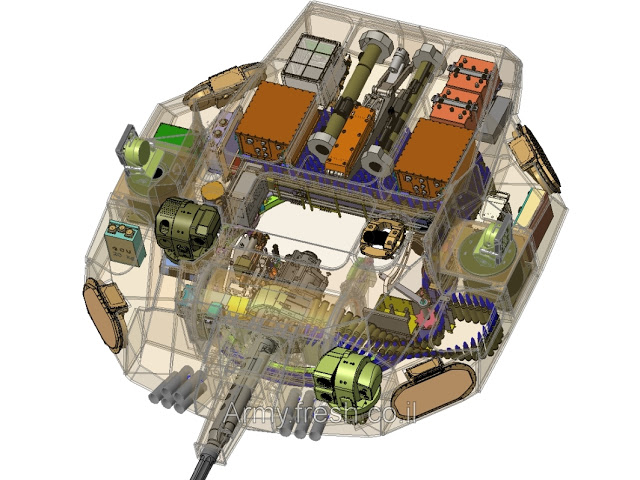A couple years ago, I wrote on the very cool experimental M1 CATTB. Having found some more information on the vehicle, I decided to revisit it.
We’ve talked a little about the new gun, engine, and turret already. Let’s look at the autoloader. The autoloader was the same chain-style autoloader found on Leclerc and K2, and it held 17 rounds of either 120 mm or 140 mm ammunition. 140 mm ammunition was two-piece, and was stored in its ready to fire configuration in the bustle, which accounts for a lot of its length. The new powerpack opened up more room at the rear of the hull, and this was used for reserve ammo stowage. The reserve stowage could hold 22 140 mm rounds separated into the two pieces, or 33 120 mm rounds. There was also a mechanical ammunition transfer system to refill the ready magazine from the reserve stowage.
The new powerpack was the AIPS, and it had a total1 volume of 4.81 m3. This is a savings of about 3.5 m3 of space, which was used for the ammunition stowage mentioned above. The engine itself displaced 1,682 cubic inches, with an oil cooling system. It used a special oil to handle higher temperatures better. A key advantage of the oil-only cooling system was that it was much more compact than a water cooling system and used less power to run the cooling fans, needing only 120 HP for the cooling fans instead of 240 like most other 1,500 HP diesels of the time.
CATTB also featured a brand new track. The old track had two 9-inch wide track shoes mounted side-by-side, spanning the width of the track pins. Track guides (which travel between the roadwheel pairs) were bolted between the shoes. The new track for the CATTB had a single 25-inch wide shoe to span the pins and integrated the track guide with the shoe. This was intended to uniformly distribute pin loading and increase track life. The goal was 5,000-6,000 miles of track life, more than double that of the older tracks, which was approximately 2,500 miles.
CATTB replaced the torsion bar suspension of the M1 with an in-arm hydropneumatic suspension system. There were two designs that were being tested. Switching to a hydropneumatic suspension saved about 1,700 pounds in the vehicle, and frees up several inches of space in the hull, to lower the vehicle silhouette or to add extra belly protection. Being a test bed, neither option was selected on the CATTB.
In my previous article, I commented on the very large number of smoke grenade dischargers on the CATTB. These were for an early soft-kill active protection system. The sensors cueing it were a radar warning receiver and a laser warning receiver. It could automatically fire smoke to obscure the tank, or automatically slew the gun to face the threat. I’d be concerned about its effectiveness without additional IR or radar-based missile approach warning systems.
CATTB was also projected to test the Multi-sensor Target Acquisition System (MTAS). This added a low-power millimeter-wave radar to the tank, with a field of view of 180° in azimuth and 7.5° in elevation. Range was projected to be about 5 km.
Since this is a test bed, it’s not intended to enter mass production, so I won’t evaluate it as such. But I will review the new features:
- I think the turret design is a pretty good one and it looks cool. If you’re going for a manned turret and aren’t trying to reduce the profile like Leclerc, I think it’s a solid design. But I’d prefer an unmanned turret like TTB/T-14.
- Provided you’re ok with the two-man turret, the autoloader is solid. The really nice feature is the auto-resupply from reserve stowage to the ready stowage of the autoloader. And 39 rounds of 140 mm is a pretty good capacity. 50 rounds of 120mm is also a good loadout.
- I’m kind of skeptical of the engine, since this hasn’t been tried anywhere else to my knowledge. There’s probably an SAE paper somewhere behind a paywall that would tell me why. Anyway, I’m also skeptical of the idea of needing ‘special oil’ for my tanks. Plus, there are some other smallish, proven 1,500 HP diesels available these days.
- New track seems better than the old track. More life and fewer parts. Sold.
- Hydropneumatic suspension is better than torsion bar suspension. More room in the floor for mine protection or more room for systems or less hull height is a really good thing. Active hydropneumatic even allows you to get a bit more elevation/depression out of your gun, which can help make the turret roof lower.
- I love active protection systems, but this seems a bit early yet. It probably would have been worked out with more testing, but I’d like more ways to cue the system. Also, I strongly prefer having hard-kill capability. At the time, it’d be worth the work, but now there are a ton of off-the-shelf systems that just work. And are hard-kill to boot.
- Radar tracking/targeting is a cool supplement to thermals. And if you set it up right, you can use it for missile approach warning too. I’d just want a way to switch it off sometimes.
- Engine, transmission, cooling system, final drives, power generators, batteries and fuel for one battlefield day ↩
